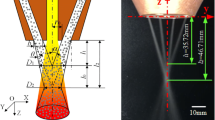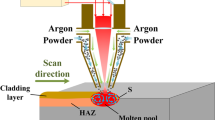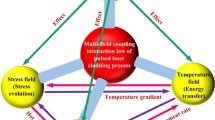Abstract
During the laser cladding process, active elements will affect the direction and speed of the molten pool flow, impacting the solidification and cladding quality of the molten pool. It is significant to quantitatively evaluate the sensitivity of the influence for the cladding process parameters on cladding quality. In this paper, a three-dimensional numerical model of the laser cladding Fe60 powder was established. The effect of sulfur element on the surface tension, fluid flow, and heat transfer were calculated and analyzed, and the instantaneous evolution laws of the temperature and flow field during the cladding process were revealed. The response surface model was established based on the Box–Behnken Design (BBD) method, and the influence of different process parameters on the cladding process were analyzed. The sensitivity was analyzed by the Monte-Carlo method. The cladding profile was observed by the scanning electron microscope (SEM) to verify the validity of the model. Calculations show that sulfur changes the direction of Marangoni convection, forming a deeper molten pool. The laser power is more sensitive to the effect of the cladding temperature, and the powder feeding rate is more sensitive to the effect of the molten pool flow rate.



























Similar content being viewed by others
References
L.Y. Chen, Y. Zhao, B.X. Song et al., Modeling and simulation of 3D geometry prediction and dynamic solidification behavior of Fe-based coatings by laser cladding. Opt. Laser Technol. 139, 107009 (2021). https://doi.org/10.1016/j.optlastec.2021.107009
J.X. Zhao, G. Wang, X.Y. Wang et al., Multicomponent multiphase modeling of dissimilar laser cladding process with high-speed steel on medium carbon steel-ScienceDirect. Int. J. Heat Mass Transf. 148, 118990 (2020). https://doi.org/10.1016/j.ijheatmasstransfer.2019.118990
C.G. Li, C.M. Liu, S. Li et al., Numerical simulation of thermal evolution and solidification behavior of laser cladding AlSiTiNi composite coatings. Coatings 9(6), 391 (2019). https://doi.org/10.3390/coatings9060391
L.Y. Chen, T.B. Yu, P.F. Xu et al., In-situ NbC reinforced Fe-based coating by laser cladding: Simulation and experiment. Surf. Coat. Technol. 412, 127027 (2021). https://doi.org/10.1016/j.surfcoat.2021.127027
Z.P. Wu, T. Li, Q. Li et al., Process optimization of laser cladding Ni60A alloy coating in remanufacturing. Opt. Laser Technol. 120, 105718 (2019). https://doi.org/10.1016/j.optlastec.2019.105718
J.T. Yu, W.L. Sun, H.B. Huang et al., Crack sensitivity control of nickel-based laser coating based on Genetic Algorithm and Neural Network. Coatings 9(11), 728 (2019). https://doi.org/10.3390/coatings9110728
A. Marchand, J.H. Weijs, J.H. Snoeijer et al., Why is surface tension a force parallel to the interface? Am. J. Phys. 79(10), 999–1008 (2012). https://doi.org/10.1119/1.3619866
S. Kou, Y.H. Wang, Three-dimensional convection in laser melted pools[J]. Metall. Trans. A 17(12), 2265–2270 (1986). https://doi.org/10.1007/BF02645924
A. Kumar, S. Roy, Effect of three-dimensional melt pool convection on process characteristics during laser cladding. Comput. Mater. Sci. 46(2), 495–506 (2009). https://doi.org/10.1016/j.commatsci.2009.04.002
L.C. Zheng, C.R. Jiao, Y.H. Lin et al., Marangoni convection heat and mass transport of power-law fluid in porous medium with heat generation and chemical reaction. Heat Transf. Eng. 38(5–8), 641–652 (2016). https://doi.org/10.1080/01457632.2016.1200384
A. Kidess, S. Kenjereš, C.R. Kleijn, The influence of surfactants on thermocapillary flow instabilities in low Prandtl melting pools. Phys. Fluids 28(6), 93–127 (2016). https://doi.org/10.1146/annurev.fluid.33.1.93
T.J. Lienert, P. Burgardt, K.L. Harada et al., Weld bead center line shift during laser welding of austenitic stainless steels with different sulfur content. Scr. Mater. 71, 37–40 (2014). https://doi.org/10.1016/j.scriptamat.2013.09.029
J.H. Yang, W. Aiyiti, H.F. Jiang et al., Evolution of molten pool morphology and prediction of inclined cladding layer morphology. Opt. Laser Technol. 142, 107164 (2021). https://doi.org/10.1016/j.optlastec.2021.107164
G.F. Lian, M.P. Yao, Z. Yang et al., Analysis and prediction on geometric characteristics of multi-track overlapping laser cladding. Int. J. Adv. Manuf. Technol. 97(9), 2397 (2018). https://doi.org/10.1007/s00170-018-2107-6
P. Wen, Z.H. Feng, S.Q. Zheng, Formation quality optimization of laser hot wire cladding for repairing martensite precipitation hardening stainless steel. Opt. Laser Technol. 65, 180–188 (2015). https://doi.org/10.1016/j.optlastec.2014.07.017
F. Mazzucato, A. Aversa, R. Doglione et al., Influence of process parameters and deposition strategy on laser metal deposition of 316l powder. Met. Open Access Metall. J. 9(11), 1160 (2019). https://doi.org/10.3390/met9111160
Y. Zhao, C. Guan, L.Y. Chen et al., Effect of process parameters on the cladding track geometry fabricated by laser cladding. Opt. Int. J. Light Electron Opt. 223, 165447 (2020). https://doi.org/10.1016/j.ijleo.2020.165447
A.A. Ferreira, R. Darabi, J.P. Sousa et al., Optimization of Direct Laser Deposition of a Martensitic Steel Powder (Metco 42C) on 42CrMo4 Steel. Met. Open Access Metall. J. 11(4), 672 (2021). https://doi.org/10.3390/met11040672
C. Li, X. Han, D.C. Zhang et al., Quantitative analysis and experimental study of the influence of process parameters on the evolution of laser cladding. J. Adhes. Sci.Technol. (2021). https://doi.org/10.1080/01694243.2021.1991142
D. Grange, A. Queva, G. Guillemot et al., Effect of processing parameters during the laser beam melting of Inconel 738: Comparison between simulated and experimental melt pool shape. J. Mater. Process. Technol. 289, 116897 (2021). https://doi.org/10.1016/j.jmatprotec.2020.116897
S.Y. Wen, Y.C. Shin, Modeling of transport phenomena in direct laser deposition of metal matrix composite. Int. J. Heat Mass Transf. 54(25–26), 5319–5326 (2011). https://doi.org/10.1016/j.ijheatmasstransfer.2011.08.011
S. Morville, M. Carin, P. Peyre et al., 2D longitudinal modeling of heat transfer and fluid flow during multilayered direct laser metal deposition process. J. Laser Appl. 24(3), 1–9 (2012). https://doi.org/10.2351/1.4726445
Y.C. Jiang, Y.H. Cheng, X.C. Zhang et al., Simulation and experimental investigations on the effect of Marangoni convection on thermal field during laser cladding process. Optik 203, 164044 (2020). https://doi.org/10.1016/j.ijleo.2019.164044
M. Do-Quang, G. Amberg, C.O. Pettersson, Modeling of the Adsorption Kinetics and the Convection of Surfactants in a Weld Pool. J. Heat Transf. 130(9), 61–71 (2008). https://doi.org/10.1115/1.2946476
X. Han, D.C. Zhang, C. Li et al., Study on a multifield coupling mechanism and a numerical simulation method of a pulsed laser deposition process from a disk laser. Appl. Phys. A 127, 17 (2021). https://doi.org/10.1007/s00339-020-04180-3
J. Song, Y.X. Chew, G.J. Bi et al., Numerical and experimental study of laser aided additive manufacturing for melt-pool profile and grain orientation analysis - ScienceDirect. Mater. Des. 137, 286–297 (2018). https://doi.org/10.1016/j.matdes.2017.10.033
Z.T. Gan, L. Hao, S.X. Li et al., Modeling of thermal behavior and mass transport in multi-layer laser additive manufacturing of Ni-based alloy on cast iron. Int. J. Heat Mass Transf. 111, 709–722 (2017). https://doi.org/10.1016/j.ijheatmasstransfer.2017.04.055
Z.T. Gan, Y. Gang, X.L. He et al., Numerical simulation of thermal behavior and multicomponent mass transfer in direct laser deposition of Co-base alloy on steel. Int. J. Heat Mass Transf. 104, 28–38 (2017). https://doi.org/10.1016/j.ijheatmasstransfer.2016.08.049
H.C. Tian, X.D. Chen, Z.H. Yan et al., Finite-element simulation of melt pool geometry and dilution ratio during laser cladding. Appl. Phys. A 125, 485 (2019). https://doi.org/10.1007/s00339-019-2772-9
P. Sahoo, T. Debroy, M.J. Mcnallan, Surface tension of binary metal-surface active solute systems under conditions relevant to welding metallurgy. Metall. Trans. B 19, 483–491 (1998). https://doi.org/10.1007/BF02657748
N.A. Nariman, K. Hamdia, A.M. Ramadan et al., Optimum design of flexural strength and stiffness for reinforced concrete beams using machine learning. Appl. Sci. 11(18), 8762 (2021). https://doi.org/10.3390/app11188762
G.R. Meng, L.D. Zhu, J.D. Zhang et al., Statistical analysis and multi-objective process optimization of laser cladding TiC-Inconel718 composite coating. Opt. Int. J. Light Electron Opt. 240, 166828 (2021). https://doi.org/10.1016/j.ijleo.2021.166828
N. Vu-Bac, X. Zhuang, T. Rabczuk, Uncertainty Quantification for mechanical properties of polyethylene based on fully atomistic model. Materials 12(21), 3613 (2019). https://doi.org/10.3390/ma12213613
D.W. Zhao, A. Osipov, A. Bezmelnitsyn et al., Statistical modeling and optimization of the resistance welding process with simultaneous expulsion magnitude consideration for high-strength low alloy steel. Int. J. Adv. Manuf. Technol. 113, 1173–1189 (2021). https://doi.org/10.1007/s00170-021-06696-1
N. Vu-Bac, T. Lahmer, X. Zhuang et al., A software framework for probabilistic sensitivity analysis for computationally expensive models. Adv. Eng. Softw. 100, 19–31 (2016). https://doi.org/10.1016/j.advengsoft.2016.06.005
T.M. Rodgers, J.A. Mitchell, V. Tikare, A Monte Carlo model for 3D grain evolution during welding. Model. Simul. Mater. Sci. Eng. 25, 064006 (2017). https://doi.org/10.1088/1361-651X/aa7f20
N. Vu-Bac, T. Lahmer, Y. Zhang et al., Stochastic predictions of interfacial characteristic of polymeric nanocomposites (PNCs). Compos. Part B 59, 80–95 (2014). https://doi.org/10.1016/j.compositesb.2013.11.014
N. Vu-Bac, R. Rafiee, X. Zhuang et al., Uncertainty quantification for multiscale modeling of polymer nanocomposites with correlated parameters. Compos. Part B 68, 446–464 (2015). https://doi.org/10.1016/j.compositesb.2014.09.008
N. Vu-Bac, M. Silani, T. Lahmer et al., A unified framework for stochastic predictions of mechanical properties of polymeric nanocomposites. Comput. Mater. Sci. 96, 520–535 (2015). https://doi.org/10.1016/j.commatsci.2014.04.066
Funding
This work was supported by Innovation Talent Support Plan Program of Higher Education Institutions of Liaoning Province (20201020).
Author information
Authors and Affiliations
Corresponding author
Ethics declarations
Conflict of interest
We declare that we do not have any commercial or associative interest that represents a conflict of interest in connection with the work submitted.
Ethical approval
All analyses were based on previously published studies; thus, no ethical approval and patient consent are required.
Consent to participate and publications
All authors agree with the participation and publication of this article.
Additional information
Publisher's Note
Springer Nature remains neutral with regard to jurisdictional claims in published maps and institutional affiliations.
Rights and permissions
Springer Nature or its licensor (e.g. a society or other partner) holds exclusive rights to this article under a publishing agreement with the author(s) or other rightsholder(s); author self-archiving of the accepted manuscript version of this article is solely governed by the terms of such publishing agreement and applicable law.
About this article
Cite this article
Jia, T., Li, C., Deng, S. et al. Parameter sensitivity evaluation of the laser cladding for Fe60 powder with different sulfur contents. Appl. Phys. A 128, 1039 (2022). https://doi.org/10.1007/s00339-022-06175-8
Received:
Accepted:
Published:
DOI: https://doi.org/10.1007/s00339-022-06175-8




